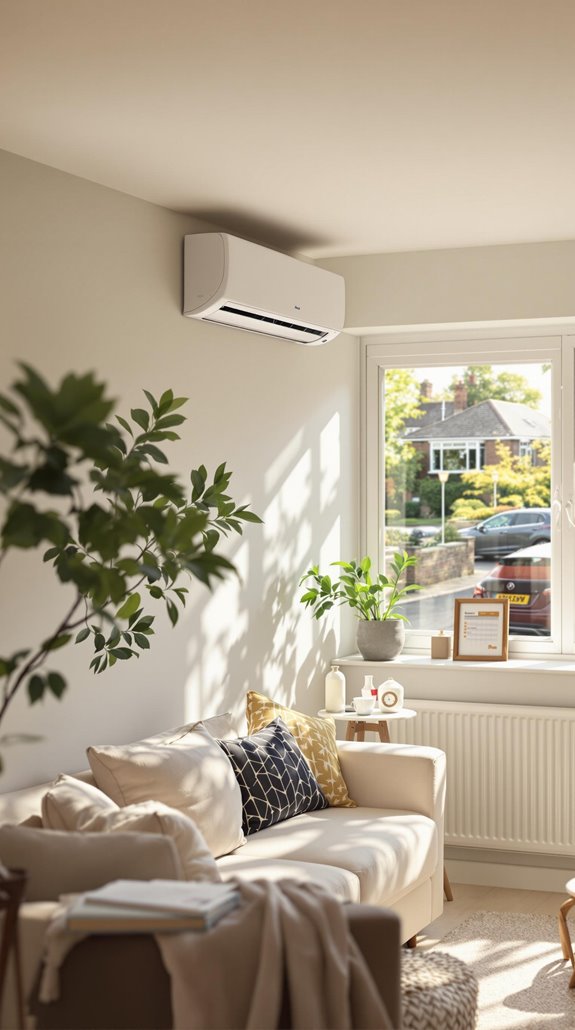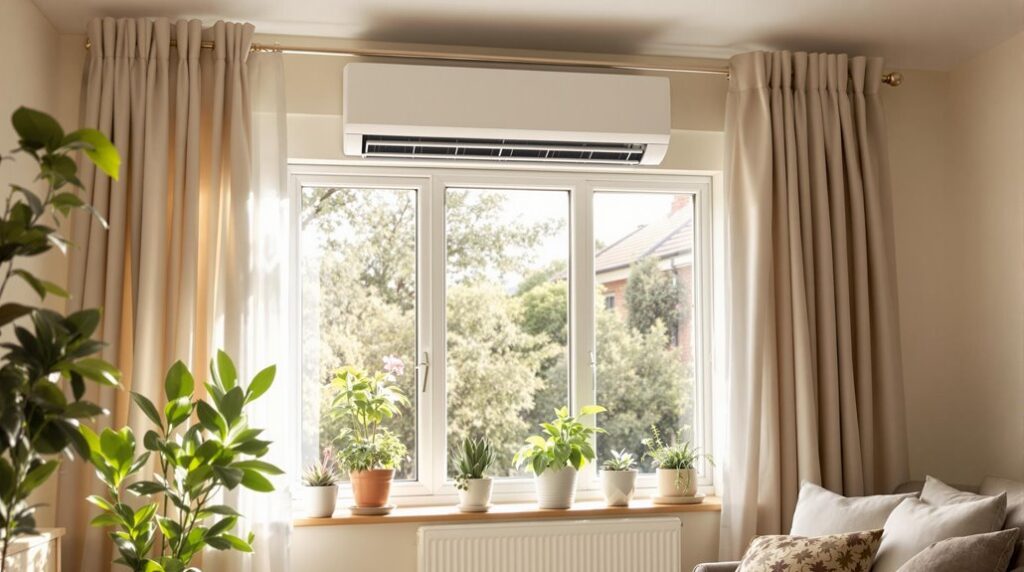I understand you’re looking to cool your home without spending a fortune, and retrofit air conditioning might be exactly what you need. After working with countless UK homeowners facing the same challenge, I’ve seen how the right AC system can transform a sweltering house into a comfortable sanctuary while keeping energy bills manageable. The key lies in choosing the correct type of system for your specific situation, but there’s more to weigh than just the upfront costs.
Key Takeaways
- Wall-mounted split systems offer the best value at £1,500–£3,500 per unit with A++ efficiency ratings.
- Portable units provide budget-friendly cooling from £200–£800, though they’re noisier and less efficient than fixed systems.
- Ductless systems are cost-effective alternatives for older homes without existing ductwork, avoiding major structural work.
- Government grants of 20–30% are available for hybrid heat pump systems, reducing upfront costs significantly.
- Efficient retrofits paired with insulation improvements can reduce running costs by 30–50% long-term.
Understanding Your Air Conditioning Options and Costs

When choosing air conditioning for your UK home, you’ll face five primary options that differ greatly in cost, efficiency, and installation requirements. Wall-mounted split systems offer the best balance, costing £1,500–£3,500 per unit with A++ efficiency ratings that’ll cut your running costs by 30–50%. If you’re renting or need flexibility, portable units start at just £200–£800, though they’re noisier and less efficient. Multi-split systems (£3,000–£8,000) let you cool multiple rooms from one outdoor unit, while ducted systems (£5,000–£15,000+) provide whole-home comfort but require major structural work. Modern air conditioning systems now provide comprehensive functionality including cooling, heating, dehumidifying, and air purification capabilities beyond just temperature control. Hybrid heat pump systems cost £7,000–£12,000 upfront but offer year-round heating and cooling, potentially qualifying for government grants that’ll reduce your investment by 20–30%.
Installation Requirements and Planning Considerations
Before you purchase any air conditioning system, proper planning and assessment will save you thousands of pounds and prevent costly mistakes. I’ll walk you through the essential requirements that’ll determine your installation success.
First, you’ll need a thorough site assessment covering room dimensions, sun exposure, and existing insulation levels. This evaluation guarantees you’re selecting the right system size and capacity for your space. Additionally, improving your garage’s energy efficiency through insulation can further enhance the overall comfort of your home.
Planning permission isn’t typically required for smaller units, but external units can’t exceed 0.6m³ and must maintain one-metre clearance from boundaries. Your installer needs F-Gas certification and relevant NVQ qualifications – don’t compromise on credentials.
If you’re dealing with an older home lacking ductwork, consider ductless systems as cost-effective alternatives. Upgrading insulation beforehand will dramatically improve efficiency and reduce long-term operating costs. Properties in designated areas may face stricter regulations, so always consult your local authority planning office before proceeding with installation.
Running Costs and Energy Efficiency Factors
Three critical factors determine your air conditioning running costs: system efficiency ratings, your home’s thermal performance, and local electricity rates. I’ll help you understand how each impacts your bills.
If your home lacks proper insulation, you’re fighting an uphill battle. Homes built before 1965 without adequate thermal protection can see 30-50% higher cooling loads. That’s money flowing straight out your windows and walls.
Look for systems with high SEER ratings – they’ll cost more upfront but deliver long-term savings. I’ve seen efficient retrofits cut energy consumption dramatically when paired with basic insulation improvements.
Consider your home’s EPC rating too. Only 40% of UK homes meet EPC C standards, meaning most of us are overpaying for comfort. Address thermal performance first, then install appropriately-sized equipment.
Remember that housing stock emissions account for approximately one-fifth of the UK’s total annual emissions, making efficient cooling choices part of the broader environmental picture.
Key Benefits of Adding AC to Your Home
Adding air conditioning to your home delivers measurable benefits that extend far beyond simple cooling. I’ll show you how this investment transforms your living experience while protecting your financial future.
Your health improves dramatically with filtered air that removes pollen, dust, and allergens. Controlled humidity prevents mold growth, while consistent temperatures reduce heat stress for vulnerable family members. Additionally, proper insulation can further enhance your home’s energy efficiency by minimizing heat loss and gain, helping you achieve lower energy bills.
Property values increase by 3-5% according to estate agents, making AC a smart investment that pays dividends when you sell. Modern heat pumps reduce carbon emissions by 60-80% compared to gas boilers, qualifying you for government efficiency programs.
Smart integration lets you control temperatures room-by-room through your phone, optimizing energy use automatically. You’ll sleep better, work more productively, and enjoy year-round comfort that makes your house truly feel like home. The precise temperature control ensures you can maintain the ideal sleeping environment even when UK temperatures soar above 30°C during increasingly frequent heatwaves.
Potential Drawbacks and Limitations to Consider
While retrofitting air conditioning offers compelling advantages, significant drawbacks demand careful consideration before you commit to this investment. I’ll be honest – costs can escalate quickly. You’re looking at £1,500 minimum for basic setups, potentially £7,000+ for whole-home systems, plus ongoing energy bills that’ll spike £100-200 seasonally. Moreover, investing in such systems could lead to unexpected cost variations similar to those seen in structural surveys for property assessments.
Installation isn’t straightforward either. You’ll face wall drilling, external unit mounting, and possible electrical upgrades. Many of us discover space constraints or compatibility issues mid-project. The aesthetic impact matters too – external compressors and visible indoor units aren’t everyone’s cup of tea.
Consider the environmental angle: refrigerants contribute to greenhouse emissions, and mass AC adoption worsens urban heating. Plus, you might need council permissions in conservation areas. These systems typically run 3-4 months yearly, questioning the investment’s value. Remember that renting restrictions may prevent you from installing fixed systems altogether.
Financial Impact and Property Value Enhancement
Despite these upfront concerns, retrofitting air conditioning can deliver substantial financial returns that often justify the initial investment. I’ve found that AC retrofits can achieve remarkable 91.14% energy savings, with payback periods averaging 5.63 years. You’ll see immediate reductions in utility bills, and the efficiency gains compound over time.
What’s particularly compelling is how these upgrades boost your property value. Energy-efficient homes in the UK see average price increases of £24,766, making your investment doubly rewarding. Properties with modern, efficient systems sell faster and often above asking prices. Additionally, investing in energy-efficient upgrades can lead to significant savings on renovation costs over time, as they often require less maintenance.
The math works in your favor: while you’re cutting energy consumption by up to 50%, you’re simultaneously future-proofing your home against rising energy costs and regulatory changes. Your retrofit becomes a strategic financial move, not just a comfort upgrade. Since the built environment accounts for 38% of global greenhouse gas emissions, your AC retrofit contributes to meaningful environmental impact reduction.
Conclusion
I’ve covered the essential factors you’ll need to evaluate when considering retrofit air conditioning for your UK home. You’ll want to weigh the upfront costs against long-term savings, assess your property’s suitability, and factor in potential government incentives. With proper planning and system selection, you can achieve significant comfort improvements while maintaining budget control. Don’t forget to get multiple quotes and consider professional energy assessments to maximize your investment’s effectiveness.
References
- https://www.mybuilder.com/insulation/price-guides/retrofitting-house-cost
- https://customheat.co.uk/news-advice/how-much-does-air-conditioning-cost-the-ultimate-guide-for-uk-homeowners/
- https://heatable.co.uk/air-conditioning/advice/is-air-conditioning-worth-it
- https://www.warmzilla.co.uk/blog/uk-air-conditioning-installation-cost
- https://trscooling.co.uk/does-air-conditioning-add-value-to-a-home-uk/
- https://heatable.co.uk/air-conditioning/advice/best-air-conditioning
- https://heatable.co.uk/air-conditioning/advice/types-of-air-conditioning
- https://www.homebuilding.co.uk/advice/types-of-air-conditioning
- https://www.praairconditioning.co.uk/air-conditioning-types/
- https://www.midlandaircon.co.uk/air-con-tip/what-are-the-different-types-of-air-conditioning-system/

